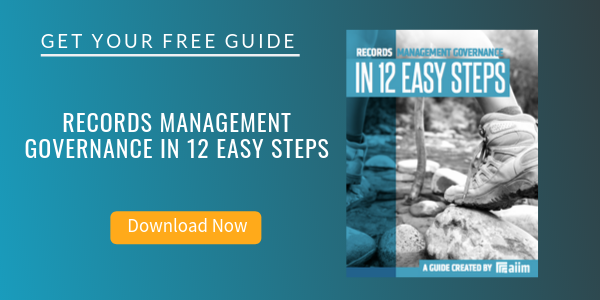%20Policies%20and%20the%20Law.jpg)
Intelligent Information Management (IIM) Policies and the Law - Part 1
Information Governance | Intelligent Information Management (IIM)
Every so often, IIM practitioners and lawyers cross paths. One such intersection is around policy writing. As practitioners modify and improve their IIM policies, it's important to keep in mind how those policies specifically relate to the law. Understanding that relationship better will help IIM and legal specialists work together more effectively.
The Principle of Hearsay*
You may be familiar with the legal doctrine of “hearsay.” It is based on the foundational principle that to prove the truth of any fact, the court will want to see the best evidence possible.
In theory, the best guarantee of the truth of a statement — spoken or written — will always come from the person who made it. It is only by subjecting the speaker or writer to a proper cross-examination of that statement that we are in a position to ascertain its truth. You cannot be cross-examined on someone else’s truth, only on your own. As a result, our starting point is the over-arching principle that you can’t submit someone else’s statement in evidence as proof of the truth of that statement. A statement made by anyone but you is considered hearsay and is inadmissible — until we can find a reason to admit it.
Simple Example
Let’s take a simple example. You receive a memo from senior management reporting that someone in the building tested positive for Covid-19, and after reading it, you decide to exit the office and stay away.
If you had to testify later in court, you could present the statement in the memo as the trigger for your decision to leave the office. You cannot present it as proof that someone in the building actually tested positive for Covid-19. You don’t know that “fact” to be true. You might have assumed it to be true, but that doesn’t make it so.
If 100 people leave the office based on what they read in the memo, it still doesn’t make the statement true. Even if you learned the next day that it was true, you can’t submit the statement as proof of the Covid-19 case; you didn’t make that statement so you can’t be cross-examined on it. The only person who can speak to the truth of the statement is the person who made it.
Exceptions to the Hearsay Rule
Hearsay was originally a very restrictive rule, excluding too much valuable evidence. Over the centuries, a number of exceptions have been established. The most important one, for our purposes here, is the “business records” exception.
Over time, an office can experience many staff changes. It would be onerous on an organization to have to go back and find every person who authored the text whenever they needed someone to testify as to the truth of that record.
So the over-arching principle has a general exception: business records — which would otherwise be hearsay — may be introduced into evidence in certain cases.
What is a Business Record?
We have to be careful here: what constitutes a “business record” under the hearsay rules is different from what constitutes a “business record” under other laws, such as tax laws, Freedom of Information laws, and privacy laws. All those other areas are much broader in their interpretation of “business records”; under hearsay, the definition is comparatively narrow.
It also differs from what constitutes a business record for the purposes of discovery in litigation. A document not meeting the requirements for business records under the hearsay exception might still be producible under the rules for discovery and used against you by the other party.
One of the more difficult challenges for IIM specialists is keeping these definitions straight.
Specific Conditions
The hearsay exception dictates a number of specific conditions under which a record kept by the business may be considered a “business record” for the purposes of the rules of evidence. The details of those specific conditions vary somewhat from jurisdiction to jurisdiction, so we can only speak in general terms here.
One of the specific conditions is that the record must be made in the ordinary course of business. The “ordinary course of business” obviously differs from one organization to another. That’s what makes it so important for business units to document their policies and procedures. Those policies and procedures form part of the proof of what constitutes the “ordinary course of business” for any particular activity.
The real question for us as IIM practitioners is, What’s the relationship between IIM policies and the “ordinary course of business”? We’ll look at that in Part 2.
*Obviously, this article cannot be taken as legal advice; it is for educational purposes only. Please forgive any over-simplification.
About Lewis S. Eisen, JD CIP CVP
Lewis S. Eisen, B.A., J.D., CIP, offers an approach to drafting policy that has been adopted by groups at organizations across Canada, the United States, and the United Kingdom. He is the author of the international bestseller ’How to Write Rules that People Want to Follow: A Guide to Writing Respectful Policies and Directives.’ Contact him for information on running a one-day workshop for your chapter or region.



